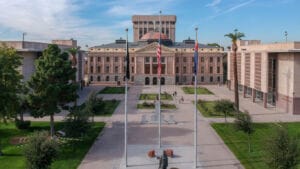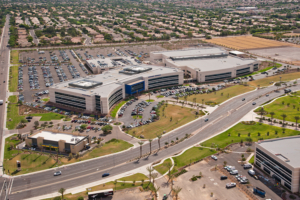BOMA Greater Phoenix launches Kilowatt Krackdown initiative to reduce energy consumption marketwide.
Last year, BOMA International announced its 7-Point Challenge, encouraging local chapter members to reduce the carbon footprint of their buildings. BOMA Greater Phoenix embraced the opportunity and formed the Green Buildings Committee to further this goal, and in the process, pursued LEED certification for one of their member’s existing buildings. This year, the committee extends the sustainability challenge to the commercial real estate community.
What is Kilowatt Krackdown
Kilowatt Krackdown, an initiative launched by the committee in July 2009, challenges the industry to take on the first 2 steps of the 7-Point Challenge:
- Decrease building energy consumption by 30% by 2012
- Benchmark energy performance through the EPA’s ENERGY STAR tool
Why
Phoenix Metro ranks 22nd in the country for the number of ENERGY STAR-qualified buildings in 2008, points out Dave Munn, principal and chief technical officer at Chelsea Group Ltd. and co-chair of the Green Buildings Committee. “Given that we are No. 5 in the country in population … we need to bolster efforts here to get more facilities to participate in this program, and show the country that we are indeed committed to energy efficiency.”
Who
Phoenix Mayor Phil Gordon was the first mayor in the United States to endorse BOMA International’s 7-point Challenge, and to begin benchmarking energy performance of municipal buildings. The committee continues to work on recruiting mayors of other cities to accept the challenge.
How
APS and SRP have partnered with the committee on the Kilowatt Krackdown initiative to sponsor an energy efficient training series for building management and maintenance staff. In a 4-hour, interactive workshop, participants learn how to use the EPA’s ENERGY STAR Portfolio Manager benchmarking program, which provides ENERGY STAR ratings on buildings, makes comparisons to similar facilities in the geographic area, tracks energy performance over time and pinpoints specific ways to save energy in the future. The online tracking system provides a print-out of kilowatt usage and a new ENERGY STAR rating every 4 to 6 weeks.
“People need tangible results,” says Susan Engstrom, senior real estate manager at Tiarna Real Estate Services and president of BOMA Greater Phoenix. “I think it’s encouraging to see a piece of paper comparing your energy usage month-to-month and year-to-year, and to get an ENERGY STAR rating each time. This gives an incentive to improve.”
The workshops also explain how to take advantage of the power companies’ resources and incentive programs. According to Jerry Ufnal, new construction liaison for the APS Solutions for Business Program and BOMA Green Buildings Committee member, the power company offers the next step to the benchmarking program.
APS and SRP can evaluate each of their customer’s facilities to identify areas in need of improvement. They can also train building operators on how to run equipment more efficiently, give rebates for energy studies and energy-efficient upgrades, and provide information on current renewable energy resources available in Arizona, such as solar, wind, geothermal, biomass and bio-gas.
“I consider energy efficiency to be one of the strongest things you can do from a green perspective,” Ufnal says. “It has tremendous advantages for building owners because they reduce the cost of operations and maintenance of their buildings, which makes them more profitable. And at the same time they are saving energy and resources. It just makes good, logical sense.”
[stextbox id=”grey”]
www.aps.com
www.aps-solutionsforbusiness.com
www.boma.org
www.bomaphoenix.org
www.chelsea-grp.com
www.energystar.gov
www.phoenix.gov
www.srpnet.com
www.tiarna.com
[/stextbox]



